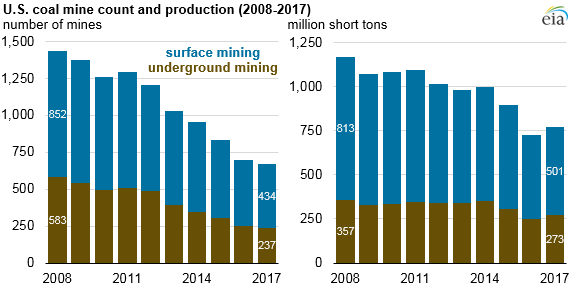Coal Production May Have Reached a Point of No Return, Per Projections

By Megan Geuss
February 9, 2019 - In President Trump's State of the Union speech last night, he didn't mention coal once, while touting oil and natural gas as having "unleashed a revolution in American energy."
The president, who has baselessly challenged the science behind climate warnings, was not expected to address renewable energy or climate change. But his omission of coal in his speech last night was notable, given that he campaigned vigorously on bringing back coal.
Just one year ago, in his 2018 State of the Union address, the president claimed that his administration "ended the war on beautiful, clean coal."
If the war on coal is over, peace for coal is a curious-looking thing.
2018 was a particularly bleak year for the industry. Coal capacity retirements actually doubled in 2018 compared to 2017, and coal production was largely flat. Recent projections from the Energy Information Administration don't show the conclusive end of the coal industry any time soon, but they do show that coal may have reached a point of no return, despite all the rollbacks of environmental regulations that the Trump administration has proposed or enacted.
Point of No Return
Last week, the EIA posted numbers showing that more than half of the US coal mines operating in 2008 were closed by 2017. Coal production has declined more slowly, as the first coal mines to be taken out of service are generally the older and less-productive ones.
Some coal mines in the Eastern United States have been buoyed by their ability to export thermal and metallurgical coal to countries like China and India, which are still burning coal at a prodigious rate. But largely the loss of coal-burning power plants to gas-burning plants in North America has translated to decreased demand for coal.

This technology shift seems to have changed energy projections from the EIA significantly. As the Financial Times points out, the EIA's projections now show that coal production is expected to decline faster over the next 30 years than it did under Obama's Clean Power Plan.
That is, in 2017, the EIA's 30-year projections took into account the then-new Trump administration's promise to repeal Obama's Clean Power Plan, which placed a cap on carbon emissions on a state-by-state basis in a way that would have particularly needled coal power plants. The EIA offered two scenarios: one where the Clean Power Plan was repealed and one in which it was not repealed.
If the Clean Power Plan was repealed, the EIA thought that the coal industry would still be churning out more than 800 million tons of coal per year by 2050. If the Clean Power Plan was not repealed, the coal industry would be producing around 600 million tons of coal per year by 2050.
Fast-forward two years, and the Trump administration has proposed repeal of the Clean Power Plan and replacement of the rule with the Affordable Clean Energy Rule, which meant to take most regulatory burdens relating to emissions off coal plants. Today, the Clean Power Plan is no longer much of a threat to the coal industry. But the EIA's projections look a lot as if the Clean Power Plan is actually being enforced. Here, the EIA's baseline projection is that the US coal industry will produce less than 600 million tons of coal per year in 2050.
If the oil and gas industry falters for some reason, coal production is estimated to be slightly higher, but if new technology makes oil and gas production cheaper over the next 30 years, coal production will be significantly leaner.
The EIA projections don't take into account any future climate-related policies, which could further put the screws to one of the most carbon intensive fuels that the US uses.

